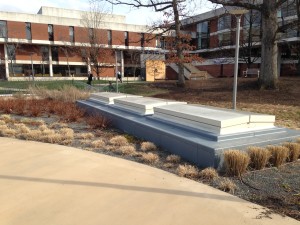No visit to Grounds is complete without a jaunt in Jefferson’s extensive and well-planned gardens. All ten contain unique plant life complete with charm and character. Jefferson intended for the gardens to be a place to study and be studied. Contained by famous serpentine walls, the gardens remain largely empty nowadays except for the occasional evening event or brilliantly sunny day when locals walk their dogs or children fence to fence through squares of lawn, flowers, shrubs, and trees.
Jefferson also left many of details of the garden to be decided by Pavillion inhabitants. Residents were allowed to plant whatever they liked, so each plot assumed a very different personality and changed often. In earlier days, beans, peas, cabbage, and fruit trees served as ornamentation and livelihood. A historical restoration of the gardens occurred in 1950, and more maintenance took place in the 1980’s. By 2003, the gardens were dramatically different from their original composition.
A brief summary of the individual gardens:
Garden I is divided by a serpentine walk bordered by azaleas, purple leaf plums, and a sweetgum tree. The garden was once bordered by fruit trees and full of rectangular beds for vegetables and herbs.
Garden II contains a diverse spread of edible plants. A large pecan tree stands amongst grape vines, blueberry bushes, four varieties of heirloom plums, and crabapple trees. The garden is also home to daylilies and a magnolia tree. The trees were planted between 1915 and 1953 by the resident of Pavillion II, Dean Ivy F. Lewis, professor of biology.
Garden III is the largest of the garden, complete two Biltmore ash trees to shade the extended lawns. Other plantings in neviusia, a goldenrain and silverbell tree.

Neviusia
Garden IV contains descendants of French marigolds planted by Jefferson. It was restored to its late eighteenth century style in 1916 by the Albemarle Gardening Club. The design included tree peonies, rose blossoms and Southern magnolias.
Garden V is dotted with two “Albemarle pippin” trees in the center of each square that defines the bottom half of the garden. The upper area is sprinkled with purple hostas and pink crepe myrtles, and defined elegantly with green boxwoods.

Albemarle Pippin Trees
Garden VI is modeled after an orchard in the middle terrace. The upper terrace is a small lawn bordered by boxwoods. Its contains a famous feature, the Merton Spire (built in 1491 and donated to the University in 1928), which was carved for Oxford’s Merton College Chapel. It can be said that VI contains the most wilderness due to its native trees and shrubs, which include sweetbay, rhododendron, and mountain laurel.

Rhododendron
Garden VII has a smaller area due to several additions. Its serpentine pathways are dotted with romantic roses.

Garden VII
Garden VIII’s main blooms of crepe myrtle, rose of sharon, and chaste trees occur during the summer. Intimate flower gardens hide behind large boxwood while oakleaf hydrangeas and roses line the walkways. A small formal orchard is home to apples, plums, and walnuts.
Garden IX also contains a wide variety of edible plants. “Cox orange” and “pippin” trees line the lower wall, pomegranate shrubs border the edges, and a large fig sits in the center. The garden was originally designed around the McGuffey ash, which stood for one hundred and fifty years before sucombing to disease in 1989. Other plants include Persian lilacs, peonies, viburnums, amelchancier, and clethra.

Amelchancier
Garden X is reminiscent of popular Southern styles of the eighteenth century. Kentucky coffee trees and a collection of boxwoods create an old-world atmosphere. An oval lawn is strapped with “elephant ears” and large hollies left over from an earlier garden.
Soil, in many ways, serves as a record for the activities that occur on its surface. Layer upon layer of minerals, organic matter, water, and air document and preserve the past, both of the land and the people. An analysis of the soil is thus a chronicle of history above the ground and a self-preserved record of underground life. The gardens are as integral to Jefferson’s vision of the University’s layout as the Lawn and architecture that frame it, and therefore their histories, as documented by the soil, are equally as important.
Post by Kendall King
Sources
http://www.virginia.edu/uvatours/gardens/gardensExplore.html
http://www.vahistorical.org/collections-and-resources/garden-club-virginia/colleges-and-universities/university-virginia
http://www.virginia.edu/uvatours/gardens/
http://www.c-ville.com/secret-gardens-uvas-pavilion-gardens-harbor-history/#.VRQ1VxDF_K0
http://www.virginia.edu/uvatours/gardens/gardensHistory.html
Picture of the Neviusia: http://www.southeasternflora.com/view_flora.asp?plantid=521
Picture of the Albemarle pippin tree: https://www.willisorchards.com/product/newtown-pippin-apple-tree#.VRcy4BDF_K0
Picture of the rhonodrenon: http://www.almanac.com/plant/rhododendrons
Picture of the amelanchier: http://commons.wikimedia.org/wiki/File:Amelanchier_lamarckii_bloeiwijze.jpg




